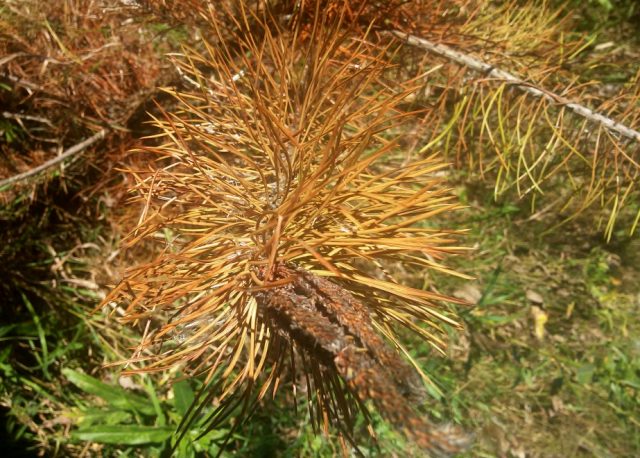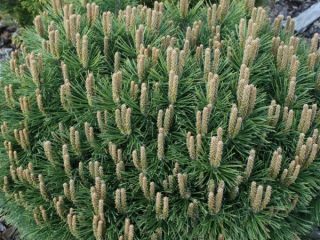Content
Pitsunda pine is most often found on the Black Sea coast of Crimea and the Caucasus. The tall tree belongs to the Pine genus from the Pine family. Pitsunda pine is classified as a variety of Turkish or Calibrian pine, without being distinguished as a separate species. Pitsunda is an Abkhazian city located in the north-west of the Black Sea coast; it is from this settlement that the name of the pine tree comes from. Pitsunda pine is an endangered species, therefore it is listed in the Red Book of Russia.
Description of Pitsunda pine
The height of an adult tree ranges from 18 to 24 m. The trunk is straight, covered with grayish-brown bark, riddled with cracks. The color of the branches differs from the trunk by being red or yellow.
The shape of the crown of a young tree is conical and wide; in older specimens it becomes spreading, acquiring a rounded outline. The branches are not densely located.
The needles are thin, pointed, and when palpated, a roughness is noted along the edge. The color of the needles is dark green. The length of the needles reaches 12 cm, and the width is insignificant - no more than 1 mm.
Male inflorescences form bunches of a reddish-yellow hue.
Most often, the cones are located singly, but can be collected in groups of 2-4 pieces. They are mounted on a short stem, but can also be sessile. The shape of the cones is ovoid-conical, length from 6 to 10 cm, diameter from 3 to 5 cm. Color - brown-red.
The cones ripen with dark, almost black colored seeds. The wing of the seed is 3–4 times longer than the seed itself.
Habitat
The largest number of specimens of Pitsunda pine grows in Abkhazia. On the territory of the Republic there is the Pitsunda-Mussersky Nature Reserve, which contains the largest pine grove on earth, spread over an area of 4 thousand hectares.
In Russia, pine forests occupy no more than 1.1 thousand hectares. Most of them (950 hectares) are located between Divnomorsk and Praskoveevskaya gap.
Pitsunda pine can be found on rocky coastal slopes. The tree is undemanding to soil and soil moisture. At the moment, artificial pine plantations created by man exceed natural ones.
The benefits of Pitsunda pine
Pitsunda pine is planted as a landscaper in landscape gardening design. Its wood is used in shipbuilding for ship cladding and in the woodworking industry to create various products.
A lot of resin and turpentine are obtained from coniferous trees. Cones collected at the stage of milky ripeness are suitable for making jam according to various recipes.
How to grow Pitsunda pine from seeds
Growing pine from seeds is labor-intensive and not always successful, but if you follow all the rules, you can cope with this task.
Seeds can be collected in a pine forest or purchased in a store.Seeds are harvested in the fall or early spring; for this, unopened cones are used. To obtain the seeds, the cones are dried for several days near heating radiators. After opening the cones, the seed material is extracted from them.
Before planting, the seeds are soaked in water; it should be renewed daily.
This will help disinfect the planting material and protect the seedling from fungal diseases.
Containers for planting must have holes so that the root system of the seedling does not rot when water accumulates at the bottom. The soil can be purchased at a specialized store or prepared yourself by mixing loose soil from a coniferous forest with peat.
The seeds are deepened 3 cm into the ground, the distance between them should be 10-15 cm. The container with the seeds is watered and covered with film. Place in a sunny and warm place. Water regularly, preventing the soil from drying out.
After the shoots appear, the film is removed. To protect the emerging sprouts from diseases, it is recommended to water the soil with a pale pink manganese solution. This measure will prevent the development of fungal diseases, but will also slow down the growth of the pine tree.
To accelerate the growth of seedlings, you can use fertilizers that are purchased in specialized stores. After about 6 months the trunk will become woody. In spring, you can transplant the seedlings into open ground. A bed with young pine trees must be loosened and removed weeds, mulch with chopped straw or sawdust. After the height of the tree reaches 0.5 m, it is transplanted to a permanent place. It is best to do this in the spring, digging out the pine tree carefully with a clod of earth so as not to damage the roots.
Planting and caring for Pitsunda pine
Pitsunda pine is a hardy coniferous tree. Dry regions with a hot climate are suitable for its cultivation. Pine perfectly tolerates air pollution and is a natural purifier, so trees can be planted even along busy highways.
Preparing seedlings and planting area
It is best to purchase a seedling with a closed root system for planting. Pitsunda pine does not tolerate drying out of its roots very well and may not take root if the seedling is dug up without a ball of earth.
This type of pine is a light- and heat-loving tree, so it should not be planted in regions with difficult weather conditions - it will freeze in the first winter.
A place for planting pine trees is chosen that is well lit, without shading. It should be noted that pine grows up to 24 m, so it should not be disturbed by canopies, electrical wires, etc. The soil should be light, not clayey, but sandy or sandy loam.
Landing rules
A layer of drainage is poured into the planting hole. You can use broken bricks, pebbles, stones and sand. The soil can be taken from a pine forest or prepared yourself by mixing peat and turf soil. Pit size: depth at least 70 cm, diameter 60 cm.
When transplanting a seedling, you must ensure that the root collar is not covered with soil; it should be left at a slight elevation from the surface.
The soil is compacted, well watered and mulched. This will prevent the soil from drying out and help eliminate weeds.
Watering and fertilizing
Young Pitsunda pine seedlings need regular watering. This helps them settle in. Mature trees can do without additional moisture; the precipitation that falls in the region is enough for them. If the summer is dry, you can arrange additional watering (no more than 3-4 times per season) or sprinkling. Coniferous trees are watered after sunset so as not to burn the crown under the scorching rays of the sun.
Seedlings grown from seeds at home need feeding for the first 2-3 years. Mature trees do not require fertilizer.
Pine trees are fed in the spring. This allows you to increase the annual growth of shoots and improves the condition of the needles, giving the needles a bright color.
For fertilizer, special multicomponent formulations are used, which include 10-15 microelements. Must be present: potassium, magnesium, phosphorus. The introduction of nitrogen compounds, manure and weed infusions is not recommended. These feedings can lead to too much growth; such shoots do not have time to adapt and prepare for winter, so they freeze out.
Mulching and loosening
Loosening the tree trunk circle is carried out carefully so as not to damage the roots of young seedlings. This procedure improves air exchange and promotes faster rooting.
Mulching consists of covering the tree trunk circle with sawdust, chopped pine needles or tree bark, and straw. The mulch layer is increased for the winter and replaced with a new one in the spring.
Mulching also prevents the growth of weeds and protects the soil from cracking.
Trimming
Pitsunda pine does not require crown formation. Sanitary pruning is carried out in spring and autumn, removing damaged or yellowed shoots.
Preparing for winter
Young pines can freeze in winter, so it is necessary to carry out preparatory measures in the fall. In October-November, moisture-recharging irrigation is carried out, the soil is covered with a thick layer of mulching material.
To prevent Pitsunda pine shoots from freezing, they are covered with insulating material. Pitsunda pines are heat-loving trees, so they are grown in the appropriate climatic zone. This pine does not survive in cold climates.
Reproduction
Under natural conditions, Pitsunda pine reproduces using seeds. You can grow a seedling yourself from seed material, but to make the task easier, it is recommended to purchase ready-made trees grown in special nurseries.
Diseases and pests
Trees can become sick due to the appearance of pests on them, violation of growing conditions, and due to the spread of infectious diseases.
The fall of needles on Pitsunda pine can be caused by the appearance of scale insects. For treatment, use Akarin (30 g), diluted in 10 liters of water. Spraying of the crown is carried out in May-June.
To combat the sawfly, biological products are used. The crown is sprayed with Lepidocide, Bitoxibacillin, and can be treated with chemicals Confidor, Actellik.
Conclusion
Pitsunda pine is an unpretentious tree suitable for growing in regions with warm climates. Coniferous seedlings can be used for landscaping the area. The tree is a tall specimen, which must be taken into account when planting.













